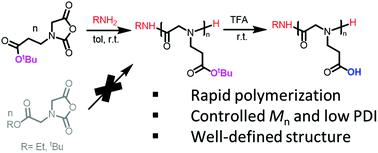当前位置:
X-MOL 学术
›
Polym. Chem.
›
论文详情
Our official English website, www.x-mol.net, welcomes your
feedback! (Note: you will need to create a separate account there.)
Controlled ring-opening polymerization of N-(3-tert-butoxy-3-oxopropyl) glycine derived N-carboxyanhydrides towards well-defined peptoid-based polyacids
Polymer Chemistry ( IF 4.1 ) Pub Date : 2021-1-5 , DOI: 10.1039/d0py01395a Bailee N. Barrett 1, 2, 3, 4 , Garrett L. Sternhagen 1, 2, 3, 4 , Donghui Zhang 1, 2, 3, 4
Polymer Chemistry ( IF 4.1 ) Pub Date : 2021-1-5 , DOI: 10.1039/d0py01395a Bailee N. Barrett 1, 2, 3, 4 , Garrett L. Sternhagen 1, 2, 3, 4 , Donghui Zhang 1, 2, 3, 4
Affiliation

|
Polypeptoids bearing carboxylic acid groups on the N-substituent are useful building blocks for the construction of peptidomimetic supramolecular assemblies with stimuli-responsive properties. Towards this end, N-(3-tert-butoxy-3-oxopropyl) glycine derived N-carboxyanhydride (tBuO2Pr-NCA) has been successfully synthesized and polymerized using primary amine initiators to produce the corresponding poly(N-(3-tert-butoxy-3-oxopropyl) glycine) with molecular weights (Mn) of 5.6–59 kg mol−1 and a narrow molecular weight distribution (PDI = 1.003–1.026). The polymerization was shown to proceed in a controlled manner, evidenced by the good agreement of the experimental molecular weight (Mn) with theoretical values and narrow molecular weight distribution in a wide range of monomer-to-initiator ratios ([M]0 : [I]0 = 25 : 1–200 : 1), the linear increase of Mn with conversion and the second-order polymerization kinetics. The cloaked carboxyl groups on the poly(N-(3-tert-butoxy-3-oxopropyl) glycine) can be readily unveiled in mild acidic conditions to yield the poly(N-(2-carboxyethyl) glycine), a structural mimic of poly(glutamic acid). The poly(N-(2-carboxyethyl) glycine) polymer is a weak polyelectrolyte whose hydrodynamic size in water can be controlled by the solution pH.
中文翻译:

N-(3-叔丁氧基-3-氧丙基)甘氨酸衍生的N-羧基酸酐向明确的类肽基多元酸的控制的开环聚合
在N-取代基上带有羧酸基团的类多肽是有用的结构单元,用于构建具有刺激响应特性的拟肽超分子组装体。为此,已经成功地合成了N-(3-叔丁氧基-3-氧丙基)甘氨酸衍生的N-羧基酸酐(t BuO 2 Pr-NCA),并使用伯胺引发剂进行聚合以生产相应的聚(N-(3 -叔丁氧基-3-氧代丙基甘氨酸),分子量(M n)为5.6–59 kg mol -1分子量分布窄(PDI = 1.003–1.026)。聚合反应以可控的方式进行,证明了实验分子量(M n)与理论值的良好吻合,并且在较宽的单体引发剂比例范围内[[M] 0 : [I] 0 = 25:1-200:1),M n随着转化率的线性增加和二级聚合动力学。聚(N-(3-叔丁氧基-3-氧丙基)甘氨酸)上的隐蔽羧基很容易在弱酸性条件下暴露出来,得到聚(N-(2-羧乙基)甘氨酸),聚谷氨酸的结构模拟物。聚(N-(2-羧乙基)甘氨酸)聚合物是一种弱聚电解质,其在水中的流体力学尺寸可以通过溶液的pH值来控制。
更新日期:2021-01-11
中文翻译:

N-(3-叔丁氧基-3-氧丙基)甘氨酸衍生的N-羧基酸酐向明确的类肽基多元酸的控制的开环聚合
在N-取代基上带有羧酸基团的类多肽是有用的结构单元,用于构建具有刺激响应特性的拟肽超分子组装体。为此,已经成功地合成了N-(3-叔丁氧基-3-氧丙基)甘氨酸衍生的N-羧基酸酐(t BuO 2 Pr-NCA),并使用伯胺引发剂进行聚合以生产相应的聚(N-(3 -叔丁氧基-3-氧代丙基甘氨酸),分子量(M n)为5.6–59 kg mol -1分子量分布窄(PDI = 1.003–1.026)。聚合反应以可控的方式进行,证明了实验分子量(M n)与理论值的良好吻合,并且在较宽的单体引发剂比例范围内[[M] 0 : [I] 0 = 25:1-200:1),M n随着转化率的线性增加和二级聚合动力学。聚(N-(3-叔丁氧基-3-氧丙基)甘氨酸)上的隐蔽羧基很容易在弱酸性条件下暴露出来,得到聚(N-(2-羧乙基)甘氨酸),聚谷氨酸的结构模拟物。聚(N-(2-羧乙基)甘氨酸)聚合物是一种弱聚电解质,其在水中的流体力学尺寸可以通过溶液的pH值来控制。











































 京公网安备 11010802027423号
京公网安备 11010802027423号